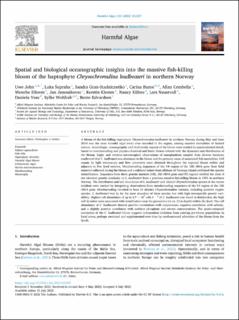| dc.contributor.author | John, Uwe | |
| dc.contributor.author | Supraha, Luka | |
| dc.contributor.author | Gran-Stadniczeñko, Sandra | |
| dc.contributor.author | Bunse, Carina | |
| dc.contributor.author | Cembella, Allan | |
| dc.contributor.author | Eikrem, Wenche | |
| dc.contributor.author | Janouskovec, Jan | |
| dc.contributor.author | Klemm, Kerstin | |
| dc.contributor.author | Kühne, Nancy | |
| dc.contributor.author | Naustvoll, Lars Johan | |
| dc.contributor.author | Voss, Daniela | |
| dc.contributor.author | Wohlrab, Sylke | |
| dc.contributor.author | Edvardsen, Bente | |
| dc.date.accessioned | 2022-12-01T10:18:33Z | |
| dc.date.available | 2022-12-01T10:18:33Z | |
| dc.date.created | 2022-08-22T12:23:42Z | |
| dc.date.issued | 2022 | |
| dc.identifier.citation | Harmful Algae. 2022, . | en_US |
| dc.identifier.issn | 1568-9883 | |
| dc.identifier.uri | https://hdl.handle.net/11250/3035266 | |
| dc.description.abstract | A bloom of the fish-killing haptophyte Chrysochromulina leadbeateri in northern Norway during May and June 2019 was the most harmful algal event ever recorded in the region, causing massive mortalities of farmed salmon. Accordingly, oceanographic and biodiversity aspects of the bloom were studied in unprecedented detail, based on metabarcoding and physico-chemical and biotic factors related with the dynamics and distribution of the bloom. Light- and electron-microscopical observations of nanoplankton samples from diverse locations confirmed that C. leadbeateri was dominant in the bloom and the primary cause of associated fish mortalities. Cell counts by light microscopy and flow cytometry were obtained throughout the regional bloom within and adjacent to five fjord systems. Metabarcoding sequences of the V4 region of the 18S rRNA gene from field material collected during the bloom and a cultured isolate from offshore of Tromsøy island confirmed the species identification. Sequences from three genetic markers (18S, 28S rRNA gene and ITS region) verified the close if not identical genetic similarity to C. leadbeateri from a previous massive fish-killing bloom in 1991 in northern Norway. The distribution and cell abundance of C. leadbeateri and related Chrysochromulina species in the recent incident were tracked by integrating observations from metabarcoding sequences of the V4 region of the 18S rRNA gene. Metabarcoding revealed at least 14 distinct Chrysochromulina variants, including putative cryptic species. C. leadbeateri was by far the most abundant of these species, but with high intraspecific genetic variability. Highest cell abundance of up to 2.7 × 107 cells L 1 of C. leadbeateri was found in Balsfjorden; the high cell densities were associated with stratification near the pycnocline (at ca. 12 m depth) within the fjord. The cell abundance of C. leadbeateri showed positive correlations with temperature, negative correlation with salinity, and a slightly positive correlation with ambient phosphate and nitrate concentrations. The spatio-temporal succession of the C. leadbeateri bloom suggests independent initiation from existing pre-bloom populations in local zones, perhaps sustained and supplemented over time by northeastward advection of the bloom from the fjords | |
| dc.language.iso | eng | en_US |
| dc.relation.uri | https://doi.org/10.1016/j.hal.2022.102287 | |
| dc.title | Spatial and biological oceanographic insights into the massive fish-killing bloom of the haptophyte Chrysochromulina leadbeateri in northern Norway | en_US |
| dc.title.alternative | Spatial and biological oceanographic insights into the massive fish-killing bloom of the haptophyte Chrysochromulina leadbeateri in northern Norway | en_US |
| dc.type | Peer reviewed | en_US |
| dc.type | Journal article | en_US |
| dc.description.version | publishedVersion | |
| dc.description.version | publishedVersion | |
| dc.source.pagenumber | 16 | en_US |
| dc.source.journal | Harmful Algae | en_US |
| dc.identifier.doi | 10.1016/j.hal.2022.102287 | |
| dc.identifier.cristin | 2044924 | |
| dc.relation.project | Norges forskningsråd: 268286 | |
| dc.relation.project | Norges forskningsråd: 282936 | |
| dc.relation.project | EU/690462 | |
| dc.relation.project | Norges forskningsråd: 314861 | |
| cristin.ispublished | true | |
| cristin.fulltext | original | |
| cristin.fulltext | original | |
| cristin.qualitycode | 1 | |

